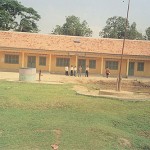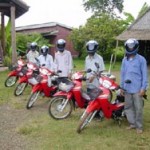While talking to my grandfather on Christmas Day, I received an update on the Pearl and Mary Flanders School he funded in Cambodia. Have you heard about the Motomen in Cambodia? As we talked, he began to explain about the Motoman project to bring internet to the remote schools and doctors. What better topic for the first “Worldly Wednesday.”

First to briefly describe the Cambodia Rural Schools Project: This project began in 1999 as a way to bring education to rural areas of Cambodia. Student’s wishing to attend school had to walk or travel by ox-cart for miles upon miles to the closest school. Many were just too far away. Through the Cambodia Rural Schools Project, over 400 schools have been donated. To build a school a donor contributes $13,000 and the Asian Development Bank matches this donation. The land for the school is donated by the village. These schools are recognized by the Cambodia government as state schools and are staffed by official state teachers.
A typical school from this project is 3 – 6 classrooms and includes basic classroom furniture such as desks and chairs. There are many other features that can be donated such as a library, solar panels, computer, vegetable garden, nurse, teacher, water well, etc.
We have become such a technology dependent society it is hard to imagine living without postal systems, phones, and the internet. But even further from our “reality” is living without medical care and educational systems. How do we not only bring school buildings but also a connection to the world? Motoman.

So, what is a “motoman”? It is really a quit simple means to bring the world to rural villages like Ratanakiri. You take a motorcycle, in this case a bright red Honda, and equip it with mobile access points and a 256 kb/s satellite uplink also referred to as a First Mile Solution. First Mile Solution based out of Boston first developed this system.
 Five days a week, these motomen travel across the rural village to schools and health care facilities to transmit and collect information. At the end of the day, they return to the hub to transmit everything collected. For individuals in these villages, whose average earnings are $1 per day, the motomen could be their only connection to the world. These schools and health center are even able to use non real time search engines!
Five days a week, these motomen travel across the rural village to schools and health care facilities to transmit and collect information. At the end of the day, they return to the hub to transmit everything collected. For individuals in these villages, whose average earnings are $1 per day, the motomen could be their only connection to the world. These schools and health center are even able to use non real time search engines!




